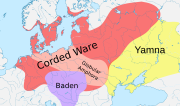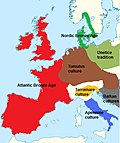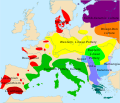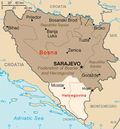Compared to earlier and contemporary cultures the Vučedol culture exploited a diversity in food sources: the Vučedol people were hunters, fishermen and...
22 KB (2,193 words) - 17:32, 19 September 2024
Vučedol Culture Museum (Croatian: Muzej vučedolske kulture) is a museum of prehistoric culture in at Vučedol, near the city of Vukovar, Croatia. The museum...
5 KB (556 words) - 13:15, 20 October 2024
Danube, which also forms the border with Serbia. Vučedol became the eponym of the eneolithic Vučedol culture. It is estimated that the site had once been...
3 KB (301 words) - 14:53, 1 March 2024
Vukovar (section Vučedol Culture Museum)
sites. The Vučedol culture, which developed in the Vučedol locality, is particularly significant for the Vukovar area. In 1938, the Vučedol dove was found...
101 KB (10,385 words) - 09:59, 23 December 2024
not biological. Prehistoric Europe Ezero culture Coțofeni culture Prehistory of Transylvania Vučedol culture Tünde Horváth, S. Éva Svingor, Mihály Molnár :...
13 KB (1,202 words) - 13:20, 4 May 2024
The Vinča culture [ʋîːnt͜ʃa], also known as Turdaș culture, Turdaș–Vinča culture or Vinča-Turdaș culture, is a Neolithic archaeological culture of Southeast...
36 KB (3,556 words) - 06:46, 18 December 2024
The Yamnaya culture or the Yamna culture, also known as the Pit Grave culture or Ochre Grave culture, is a late Copper Age to early Bronze Age archaeological...
68 KB (7,066 words) - 16:37, 17 December 2024
reaching as far as the Adriatic coast. It was preceded by the Vučedol culture. The end of this culture is not clear. According to N. Tasic, its decline would...
5 KB (555 words) - 02:15, 1 November 2024
Bell Beaker culture complex as an amalgam of the Vučedol and Yamna culture, formed after the incursion of the Yamna people into the Vučedol milieu and...
166 KB (19,274 words) - 16:04, 23 December 2024
The Capsian culture was a late Mesolithic and Neolithic culture centered in the Maghreb that lasted from about 8,000 to 2,700 BC.[is this date calibrated...
10 KB (1,000 words) - 03:30, 3 October 2024
The Peiligang culture was a Neolithic culture in the Yi-Luo river basin (in modern Henan Province, China) that existed from about 7000 to 5000 BC. Over...
5 KB (466 words) - 22:07, 29 October 2023
The Tumulus culture (German: Hügelgräberkultur) was the dominant material culture in Central Europe during the Middle Bronze Age (c. 1600 to 1300 BC)...
23 KB (2,077 words) - 19:38, 5 December 2024
Hunter-Gatherers. Ancient peoples of Italy Prehistoric Italy Terramare culture Vučedol culture Coles, John M.; Harding, A. F. (1979). The bronze age in Europe:...
11 KB (1,253 words) - 14:53, 15 November 2024
describes the early Cetina culture as a "syncretistic Bell Beaker culture", splitting off from the dissolving variant of the Vučedol complex, and at the same...
18 KB (1,750 words) - 22:27, 28 November 2024
El Khiam The Khiamian culture is a Neolithic archaeological culture of Southwest Asia, dating to the earliest part of the Pre-Pottery Neolithic A (PPNA)...
8 KB (803 words) - 01:57, 15 October 2024
Romania belonging to the Wietenberg culture, a gold dagger from Mala Gruda in Montenegro belonging to the Vučedol culture, a gold dagger from Dabene in Bulgaria...
78 KB (8,275 words) - 17:04, 13 November 2024
used, the Vučedol culture arose (c. 3000 BC – c. 2200 BC), named after the locality of Vučedol, on the bank of the Danube near Vukovar. Vučedol, near Vukovar...
9 KB (1,238 words) - 05:46, 11 March 2024
The Urnfield culture (c. 1300–750 BC) was a late Bronze Age culture of Central Europe, often divided into several local cultures within a broader Urnfield...
104 KB (11,112 words) - 21:57, 2 October 2024
4th millennium BC (section Culture)
spanned the years 4000 BC to 3001 BC. Some of the major changes in human culture during this time included the beginning of the Bronze Age and the invention...
20 KB (2,117 words) - 15:52, 14 October 2024
Terramare culture was a dominant component of the Proto-Villanovan culture—especially in its northern and Campanian phases and the Terramare culture has been...
17 KB (1,874 words) - 13:12, 1 November 2024
The Linear Pottery culture (LBK) is a major archaeological horizon of the European Neolithic period, flourishing c. 5500–4500 BC. Derived from the German...
76 KB (8,518 words) - 01:30, 10 December 2024
III - Kostolac-Vučedol A-B. During the evolution of the Coţofeni culture, there were clearly relationships with other neighbouring cultures. The influence...
8 KB (741 words) - 07:44, 6 November 2024
The first Indo-Europeans are thought to be members of eneolithic Vučedol culture. In the Bronze Age the area is thought to have been inhabited by Iron...
14 KB (1,266 words) - 07:33, 26 November 2024
This is a list of Neolithic cultures of China that have been unearthed by archaeologists. They are sorted in chronological order from earliest to latest...
17 KB (606 words) - 13:07, 7 October 2024
Brak Tell Sabi Abyad Tell Arpachiyah Tepe Gawra Chagar Bazar The Halaf culture is a prehistoric period which lasted between about 6100 BC and 5100 BC...
11 KB (1,056 words) - 04:34, 17 June 2024
Between 3000 BC and 2400 BC, Syrmia was at the centre of Indo-European Vučedol culture. Sirmium was conquered by Romans in the first century BC and became...
27 KB (2,798 words) - 00:24, 29 November 2024
The Argaric culture, named from the type site El Argar near the town of Antas, in what is now the province of Almería in southeastern Spain, is an Early...
14 KB (1,412 words) - 10:42, 26 October 2024
The so-called "Vučedol dove", one of the most well-known emblems of the prehistorical Vučedol culture, is now interpreted as representing a male partridge...
10 KB (901 words) - 14:21, 11 December 2024
Neolithic (redirect from Neolithic American culture)
Erlitou culture Xia dynasty Ertebølle culture Hembury culture Hemudu culture Hongshan culture Houli culture Horgen culture Kura–Araxes culture Liangzhu...
79 KB (8,105 words) - 19:09, 27 November 2024


























